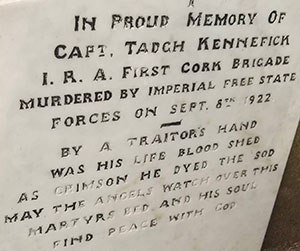Civil War dismissed and downplayed
Published in Issue 5 (September/October 2021), Letters, Volume 29
Above: ‘MURDERED BY IMPERIAL FREE STATE FORCES ON SEPT. 8TH 1922’—the memorial stone of Capt. Tadgh Kennefick, IRA First Cork Brigade.
Sir,—There appears to be an ever-growing trend to dismiss the Civil War and to downplay it within the ‘decade of centenaries’. In his letter, ‘The failings of past generations’ (HI 29.4, July/August 2021), Joe Coy argues that, because the ‘butcher’s list’ is short in comparison to civil wars in the same period, it should, by implication, be consigned to the backwaters of Irish history. He follows by stating that the relative stability after 1923 is further reason to see the conflict as of little lasting consequence.
This argument reflects a wider and growing attempt to confine and constrain interpretation of the Civil War. Some argue that there was no ‘civil war’ because the combatants ultimately believed in the same objectives. It is also presented as inflated by the British to portray the Irish as a ‘rabble who will fight with anyone’. Tempting as this may be, there is actually little evidence to demonstrate that argument. Rather, Ireland was something the British would rather forget, including those who served there.
Let us be under no illusion: this was a war. Whilst Coy is interested in a numbers game, it nevertheless meets the Uppsala conflict definition. It certainly had an impact on those who lost their lives and those left injured and destitute. In the midst of the killing, Ireland lost key figures who would have been instrumental in her development—Collins, Lynch, Brugha, Boland, Childers etc. It ignores the almost complete absence of female involvement in post-Civil War state politics in contrast to those involved in the cause of the Republic. It also denies the fact of the thousands who had to leave Ireland not because of the economic situation but because state and civil authorities would not employ those who had been aligned with the republican cause. The war was not just about killing; by late 1922 the anti-Treatyites’ arms were only rarely used in direct assaults. They were mainly directed to wreck the Free State’s economy and to impose a rival system of ‘law’. Cabinet minutes of December 1922 show that ‘State funds are almost exhausted’ and the president, W.T. Cosgrave, ‘had to go to the Bank of Ireland to ask for more loans’. The numbers criteria would also apply to the War of Independence but no corresponding pleas to tone down commemoration were made in that regard.
However, for Coy not to reference the legacy of partition is disingenuous and selective. Although partition was an established fact at the beginning of the Civil War, the conflict in the South only served to further undermine any possibility of reunification. Thus the Civil War is one of the factors that has contributed to the 30 years of conflict in Northern Ireland.
Whilst it’s true that some participants swapped allegiance—nor was it unusual for a whole unit to simply follow the prevailing view of their commanders—to regard this as an unprincipled affair is wide of the mark. Many of those involved were very clear about their stance and there are endless quotations from both sides demonstrating clear lines of division. The simple memorial stone of Capt. Tadgh Kennefick, IRA First Cork Brigade, states ‘murdered by Imperial Free State Forces’. It speaks volumes.
For years Ireland has been unable to look the Civil War in the eye—it was a dirty subject and too painful. Many of us will have been at family gatherings where the mere mention of Collins or de Valera could bring proceedings to a sudden halt. In recent years our understanding has been enhanced by many excellent locally based studies. This must continue and the period 1922–3 must not be a postscript but seen as seminal in its own right.—Yours etc.,
STEPHEN BROWN
Sheffield
















